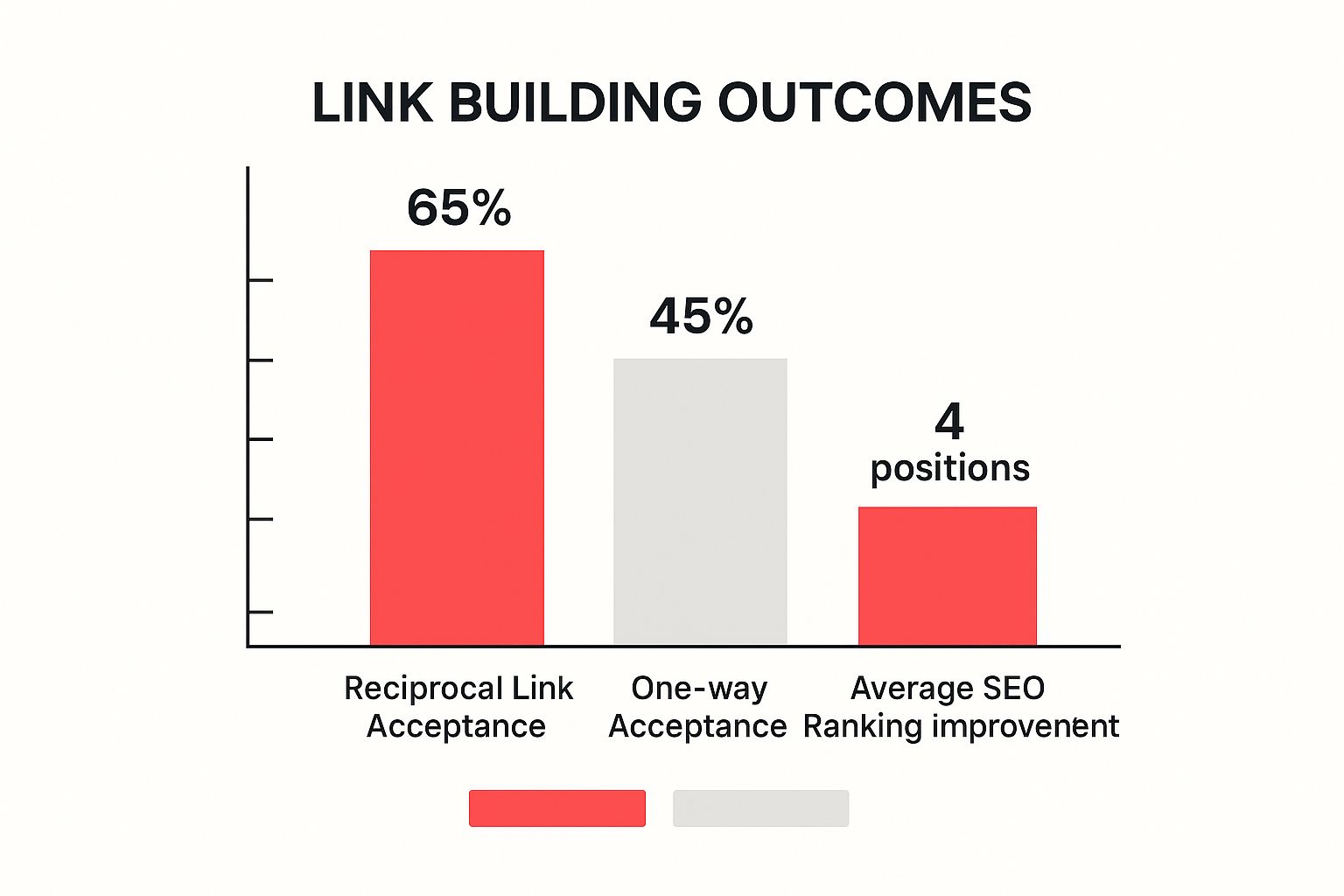Link Exchange for SEO: Boost Your Rankings Safely
Learn how link exchange for SEO can improve rankings. Discover best practices, risks, and tips to build effective reciprocal links safely.

Have you heard that link exchanges are a dead SEO tactic? Think again. A surprising analysis found that a staggering 43.7% of top-ranking pages have reciprocal links, proving this old-school method is far from obsolete. The real challenge isn't whether it works, but how to do it safely.
This guide cuts through the noise to show you how to forge valuable partnerships that boost your authority without risking a Google penalty.
Does Link Exchange Still Work for SEO?

Let's settle this debate once and for all. A link exchange is simply two websites agreeing to link to each other. Despite its sketchy reputation, the answer to whether it still works is a firm "yes"—but it all comes down to how you do it.
Think of it like a professional endorsement. A recommendation from a respected industry peer carries serious weight, while a random shoutout feels forced. The same logic applies online.
The Modern View on Reciprocal Links
The golden rule of modern link building, as detailed in our comprehensive link building best practices guide, is user value. Search engines want to see links placed naturally within content because they genuinely help the reader.
When a link exchange meets this standard, it can be a fantastic SEO tool. It only becomes a problem when it's done just to game the system with low-quality, irrelevant sites.
Still, the data shows that 24.8% of SEO experts plan to use link exchanges in 2025, proving its value when done right. You can dive deeper into link building trends and statistics to see how it fits into today's strategies.
A great link exchange isn't about swapping URLs. It's about building a partnership that provides real value to both of your audiences. The goal is to create a connection that looks and feels natural because it is natural.
The Hallmarks of a Beneficial Exchange
So, what separates a good link from a bad one? A strategic link exchange is built on relevance and authority.
The websites should share a similar audience or operate in complementary niches, making the link feel like a natural fit.
Here’s what a positive link exchange looks like:
- Topical Relevance: Both sites are in the same or a closely related industry.
- Audience Alignment: The exchange introduces each site's readers to genuinely useful content.
- Editorial Context: The links are placed naturally within high-quality content where they add value.
- Site Authority: Both sites have a solid reputation, good traffic, and a clean backlink profile.
This guide will walk you through how to find these valuable exchanges that build authority without risking penalties.
How Google's View of Link Exchange Evolved

To understand today's rules for link exchange for SEO, you have to rewind to the early days of search. It was a digital "Wild West" where rankings were easy to game.
Automated networks and shady link farms were everywhere. You could trade hundreds of links with almost zero effort, artificially pumping up your site's authority. This created a huge headache for search engines.
The Penguin Update Changes Everything
Google’s core mission has always been to deliver the most relevant, high-quality results. All the link spam and manipulation schemes were a direct threat to that mission.
That threat was met by the Google Penguin algorithm update in 2012. It was a seismic shift in the world of SEO.
Penguin was built to find, devalue, and penalize sites with unnatural backlink profiles. Overnight, websites built on these tricks saw their rankings tank. You can read up on how Google combats link spam to see their current policies.
The Penguin update sent a crystal-clear message to the SEO community: Google will reward links that are editorially placed and genuinely help users. It will punish links created just to manipulate rankings.
This update forced everyone to rethink their strategies. The game was no longer about just getting links; it was about earning them with great content and real relationships.
Clarifying Google's Stance Today
This history lesson clears up a massive misconception. Many people think "reciprocal links" are totally forbidden by Google, but that's not quite right.
What Google's guidelines actually target are excessive and unnatural linking patterns. A few relevant, editorially placed reciprocal links between two high-quality sites are perfectly fine.
The red flag for Google is a large-scale, systematic exchange that obviously exists only to boost rankings.
Let's break it down with an example:
- A Natural Exchange: A food blogger links to a local farm where they bought ingredients. The farm, in turn, links to the recipe on their "community features" page.
- An Unnatural Scheme: A hundred websites in unrelated niches—from plumbing to pet grooming—all link to each other from a generic "partners" page.
Understanding this evolution helps you see links the way Google does. When a link exchange for SEO is approached with relevance and user experience at its core, it aligns with what search engines want to see.
Weighing the Risks and Rewards of Reciprocal Links
A smart link exchange for SEO is a high-risk, high-reward play. Get it right, and you can open up a new channel for referral traffic and forge solid industry connections.
Get it wrong, and you could face a Google penalty, a hit to your brand's reputation, and a blow to your site's authority.
It’s a balancing act where knowing the difference between a good and bad exchange is everything. This infographic breaks down key stats and shows why reciprocal links are still such a common tactic.

The data makes it clear: partnership-based requests for a link swap have a much better shot at success than cold outreach. This often leads to real, measurable bumps in rankings.
The Potential Rewards of a Good Link Exchange
When done right, a link swap is more than just a trade for link equity. The biggest win is getting a high-quality backlink from a relevant, authoritative site.
These partnerships can also drive qualified referral traffic. A visitor clicking from a trusted site in your niche is already interested in what you offer.
Don’t forget the human element. Link exchanges are a fantastic way to build professional relationships that can blossom into future collaborations.
Understanding the Dangers of a Bad Link Exchange
The risks here are no joke. The most immediate threat is a Google penalty.
Piling up low-quality or irrelevant reciprocal links is a textbook sign of a manipulative link scheme. A penalty can crater your search rankings, and recovery is a long, painful process.
What’s more, linking your brand to spammy sites can do real damage to your reputation. If your audience sees you pointing to sketchy sources, they’ll question your credibility.
The core principle is simple: if a link doesn't provide genuine value to your readers, it's not worth the risk. A bad link exchange prioritizes the transaction over the user experience, which is a direct violation of Google's guidelines.
When links are swapped between relevant websites, they’re a net positive. But when you trade with any site that says yes, you cross a line that can trigger penalties. For a deeper dive, check out what Bluehost says about reciprocal links and Google's guidelines.
Distinguishing a Good Exchange from a Bad One
To help you vet opportunities, it helps to see the good and the bad side-by-side. The table below breaks down what separates a strategic partnership from a risky deal.
Good Link Exchange vs. Bad Link Exchange
This table is your cheat sheet for spotting the difference. Use this framework to screen every potential partner and keep your website safe.
| Characteristic | Good Exchange (Strategic & Safe) | Bad Exchange (Manipulative & Risky) |
|---|---|---|
| Relevance | Sites share a similar audience or are in a complementary niche. | Sites are in completely unrelated industries (e.g., plumber & baker). |
| Link Placement | Placed contextually within relevant, high-quality content. | Placed on a generic "Partners" or "Links" page with many others. |
| Primary Goal | To provide value to the reader and build a real relationship. | Solely to manipulate search engine rankings. |
| Site Quality | Both sites have strong authority, good content, and traffic. | One or both sites have low authority, thin content, or a spammy profile. |
| Scale of Exchange | A handful of thoughtful, curated exchanges. | A large-scale, automated exchange with dozens or hundreds of sites. |
| Anchor Text | Natural, descriptive, and varied (e.g., "new marketing data"). | Over-optimized with exact-match keywords (e.g., "best cheap widgets"). |
Keep these points in mind, and you’ll be in a much better position to build links that help, not hurt, your SEO efforts.
How to Find and Vet Quality Link Partners

Finding the right partners for a link exchange for SEO is about having a solid, repeatable process. Forget sending random emails and hoping for the best.
The goal is to find sites that are not only on-topic but also carry real authority in your space. We’ll walk through exactly how to find them and kick off a genuine conversation.
Uncovering Prospects Through Competitor Analysis
One of the most effective ways to find link partners is to see who’s already linking to your competition. If a website links to one of your rivals, they've already shown interest in your topic.
Fire up an SEO tool like Ahrefs or Semrush and plug in a competitor’s domain. The "Referring Domains" report will give you a list of every site linking to them.
Your mission is to pinpoint sites that are relevant but not direct competitors. This trick helps you build a laser-focused list of prospects already active in your world.
Engaging in Professional Communities and Forums
Another great way to find partners is to hang out where they hang out. This means becoming an active member of industry-specific forums, Slack channels, and LinkedIn groups.
But here’s the key: don't just jump in and start asking for links. Focus on building real relationships first by answering questions and contributing to the conversation.
When you treat a link exchange like a partnership instead of a transaction, your success rate goes through the roof. People are way more likely to work with someone they actually know and respect from their professional circles.
This approach flips the script from cold outreach to a warm introduction. It creates openings for a natural link exchange for SEO to come from real conversations, supported by proven outreach link building fundamentals.
A Practical Vetting Checklist for Potential Partners
Once you've got a list of potential partners, you need a quick way to decide who’s worth your time. Run every prospect through this checklist before reaching out.
- Topical Relevance: Is their content directly related or complementary to yours?
- Website Quality: Does the site look professional and well-cared-for?
- Content Quality: Are they publishing well-written, genuinely helpful, and original content?
- Domain Authority (DA) or Domain Rating (DR): Aim for 30+ as a general sign of a strong site. You can get the full rundown on how Moz defines Domain Authority.
- Organic Traffic: Is the site getting real visitors from search engines?
- Healthy Backlink Profile: Take a quick peek at their own backlinks. Are they earning links from other legit sites?
This checklist will help you quickly weed out low-quality sites and focus your energy on valuable partners.
Executing a Natural and Effective Link Exchange Strategy
Alright, let's pull all these concepts together into a strategy that works today. The golden rule is simple: quality over quantity.
An overwhelming 93.8% of link builders now prioritize the quality of their links above all else. With backlinks still a top-three ranking factor, one stellar link is worth more than a dozen mediocre ones. You can learn more about the impact of quality backlinks on rankings.
Place Links Within Valuable Content
Rule number one for any link is that it has to make sense. A link should never feel shoehorned in or out of place.
It needs to be editorially justified, meaning it adds real value for the reader. The old tactic of hiding links on a generic "Partners" page is dead.
Instead, your links should live inside the body of a relevant blog post or guide. That way, the link becomes a natural part of the user's journey.
Use Descriptive and Varied Anchor Text
The anchor text—the clickable text in a hyperlink—is a huge signal for search engines. Blasting it with the same keyword-stuffed phrase over and over is a massive red flag.
A healthy anchor text profile is diverse. It should tell the reader exactly what they're about to see when they click.
Here are a few examples of natural anchor text styles:
- Branded: "According to a study by Linkyleap..."
- Naked URL: "You can find the data at https://example.com/study..."
- Generic: "click here to see the results"
- Descriptive Phrase: "research on user engagement metrics"
Mixing it up makes your backlink profile look organic and earned.
A great link exchange is invisible to the average reader. It fits so perfectly within the content that it feels like a natural part of the article, not a pre-arranged deal.
Diversify Your Backlink Portfolio
If you rely only on link exchanges, you're playing a risky game. A healthy backlink profile is diversified.
If Google sees that almost all your links are reciprocal, it's a clear signal that something fishy is going on.
Methods for a Diverse Profile:
- Guest Posting: Writing articles for other reputable sites in your niche.
- Digital PR: Creating newsworthy content that journalists and bloggers want to cite.
- Resource Page Link Building: Getting your site listed on pages that compile helpful resources.
- Broken Link Building: Finding broken links on other sites and offering your content as a replacement.
When link exchanges are just one piece of this bigger puzzle, they blend in seamlessly.
Consider Advanced Exchange Tactics
To reduce any hint of a direct swap, some SEOs use more sophisticated setups like three-way link exchanges. This tactic breaks the obvious reciprocal pattern, making it harder for algorithms to detect.
Here’s how a three-way (or ABC) exchange works:
- Site A links to Site B.
- Site B then links to Site C.
- Finally, Site C links back to Site A.
This creates a clean loop where no two sites are directly linking back and forth. While more complex to set up, it adds a layer of safety for those who are extra cautious.
Got Questions About Link Exchanges? We've Got Answers.
Even with a solid plan, executing link exchanges for SEO can feel like walking a tightrope. A few questions always pop up.
Let's clear up some of the most common ones to help you navigate this strategy with confidence.
How Many Reciprocal Links Are Too Many?
There’s no magic number here. It’s all about your overall backlink profile.
If a huge chunk of your links are direct swaps, Google's alarm bells might start ringing. A healthy profile is a mix of guest posts, organic mentions, and a few reciprocal links.
Should I Exchange Links With a Competitor?
Believe it or not, yes! This can be a surprisingly powerful move if you're smart about it.
You’d almost never want to link to a competitor's product page. However, linking to their killer blog post or original research can be a massive signal of authority.
What Is a Three-Way Link Exchange?
A three-way link exchange, or an "ABC" exchange, is a clever way to build links without a direct swap. This makes the connection harder for search engines to spot as a coordinated scheme.
Here’s the breakdown:
- Site A links to Site B.
- Site B links to Site C.
- Site C then links back to Site A.
While this method is safer, it's also much trickier to organize and track.
How Can I Request a Link Exchange Without Sounding Spammy?
It all comes down to personalization and mutual value. Don't send a generic, copy-pasted template.
Start by mentioning a specific piece of their content you genuinely found useful. Then, explain where a link would fit naturally on one of your pages and how you could return the favor.
Ready to build powerful, relevant backlinks without the headache of cold outreach? Linkyleap connects you with thousands of verified partners in your niche, making the whole link exchange process a breeze.
Join our community and start building authority the smart way.


